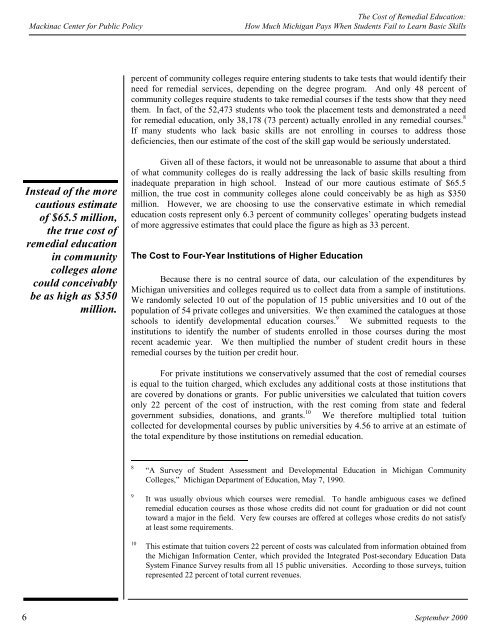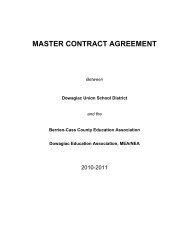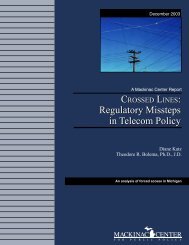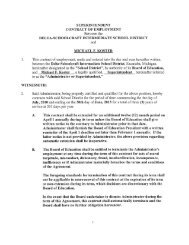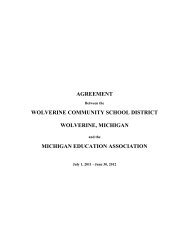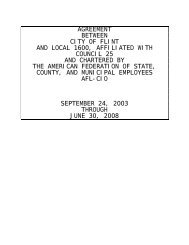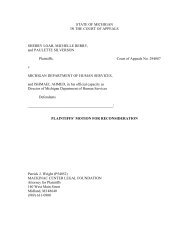The Cost of Remedial Education - Mackinac Center
The Cost of Remedial Education - Mackinac Center
The Cost of Remedial Education - Mackinac Center
You also want an ePaper? Increase the reach of your titles
YUMPU automatically turns print PDFs into web optimized ePapers that Google loves.
<strong>The</strong> <strong>Cost</strong> <strong>of</strong> <strong>Remedial</strong> <strong>Education</strong>:<br />
<strong>Mackinac</strong> <strong>Center</strong> for Public Policy How Much Michigan Pays When Students Fail to Learn Basic Skills<br />
percent <strong>of</strong> community colleges require entering students to take tests that would identify their<br />
need for remedial services, depending on the degree program. And only 48 percent <strong>of</strong><br />
community colleges require students to take remedial courses if the tests show that they need<br />
them. In fact, <strong>of</strong> the 52,473 students who took the placement tests and demonstrated a need<br />
for remedial education, only 38,178 (73 percent) actually enrolled in any remedial courses. 8<br />
If many students who lack basic skills are not enrolling in courses to address those<br />
deficiencies, then our estimate <strong>of</strong> the cost <strong>of</strong> the skill gap would be seriously understated.<br />
Instead <strong>of</strong> the more<br />
cautious estimate<br />
<strong>of</strong> $65.5 million,<br />
the true cost <strong>of</strong><br />
remedial education<br />
in community<br />
colleges alone<br />
could conceivably<br />
be as high as $350<br />
million.<br />
Given all <strong>of</strong> these factors, it would not be unreasonable to assume that about a third<br />
<strong>of</strong> what community colleges do is really addressing the lack <strong>of</strong> basic skills resulting from<br />
inadequate preparation in high school. Instead <strong>of</strong> our more cautious estimate <strong>of</strong> $65.5<br />
million, the true cost in community colleges alone could conceivably be as high as $350<br />
million. However, we are choosing to use the conservative estimate in which remedial<br />
education costs represent only 6.3 percent <strong>of</strong> community colleges’ operating budgets instead<br />
<strong>of</strong> more aggressive estimates that could place the figure as high as 33 percent.<br />
<strong>The</strong> <strong>Cost</strong> to Four-Year Institutions <strong>of</strong> Higher <strong>Education</strong><br />
Because there is no central source <strong>of</strong> data, our calculation <strong>of</strong> the expenditures by<br />
Michigan universities and colleges required us to collect data from a sample <strong>of</strong> institutions.<br />
We randomly selected 10 out <strong>of</strong> the population <strong>of</strong> 15 public universities and 10 out <strong>of</strong> the<br />
population <strong>of</strong> 54 private colleges and universities. We then examined the catalogues at those<br />
schools to identify developmental education courses. 9 We submitted requests to the<br />
institutions to identify the number <strong>of</strong> students enrolled in those courses during the most<br />
recent academic year. We then multiplied the number <strong>of</strong> student credit hours in these<br />
remedial courses by the tuition per credit hour.<br />
For private institutions we conservatively assumed that the cost <strong>of</strong> remedial courses<br />
is equal to the tuition charged, which excludes any additional costs at those institutions that<br />
are covered by donations or grants. For public universities we calculated that tuition covers<br />
only 22 percent <strong>of</strong> the cost <strong>of</strong> instruction, with the rest coming from state and federal<br />
government subsidies, donations, and grants. 10 We therefore multiplied total tuition<br />
collected for developmental courses by public universities by 4.56 to arrive at an estimate <strong>of</strong><br />
the total expenditure by those institutions on remedial education.<br />
8<br />
9<br />
10<br />
“A Survey <strong>of</strong> Student Assessment and Developmental <strong>Education</strong> in Michigan Community<br />
Colleges,” Michigan Department <strong>of</strong> <strong>Education</strong>, May 7, 1990.<br />
It was usually obvious which courses were remedial. To handle ambiguous cases we defined<br />
remedial education courses as those whose credits did not count for graduation or did not count<br />
toward a major in the field. Very few courses are <strong>of</strong>fered at colleges whose credits do not satisfy<br />
at least some requirements.<br />
This estimate that tuition covers 22 percent <strong>of</strong> costs was calculated from information obtained from<br />
the Michigan Information <strong>Center</strong>, which provided the Integrated Post-secondary <strong>Education</strong> Data<br />
System Finance Survey results from all 15 public universities. According to those surveys, tuition<br />
represented 22 percent <strong>of</strong> total current revenues.<br />
6 September 2000


